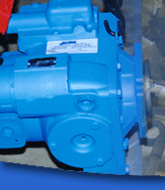

|
|
The addition of a transducer and conditioning electronics to a hydraulic actuator rotary or linear creates a system which responds rapidly and accurately to control signals for position and velocity, without the need for mechanical re-setting. By combining the sophistication of electronics with the enormous power densities offered by hydraulic motion, greater machine flexibility is achieved and set-up times are cut to a minimum.
To select a feedback device for a specific application, a balance has to be achieved between accuracy, cost and durability. ServoCon ALPHA offers a full range of linear magnetostrictive and inductive transducers and rotary servotachs and encoders. ServoCon ALPHA can supply rotary actuators and cylinders fitted with almost any transducer requested by the customer.
 |
 |
 |
Linear Displacement Transducer
The linear displacement transducer or LDT is a magnetostrictive device
which provides analog or digital information of actuator position through
the interaction of two magnetic fields. Applications for the LDT include
closed loop feedback to achieve accurate position, velocity or motion
control. On open loop systems, an LDT may be used as a continuous, infinite
resolution position monitoring device.
Rotary Displacement Transducer
The rotary displacement transducer or RDT may be a potentiometer, servotach
or encoder device which provides analog or digital information indicating
actuator angular position. Applications for rotary actuators include closed
loop feedback to achieve accurate angular position, velocity or motion
control. On open loop systems, an LDT may be used as a continuous, infinite
resolution position monitoring device.
Applications
ServoCon ALPHA feedback systems offer precision control of a wide variety
of applications, including:
- Machine tools
- Robots
- Flight simulators
- Woodworking machinery
- Paper machinery
- Valve mechanisms
- Injection molding equipment
- Marine stabilization systems
- Rubber processing equipment
- Aerial and antenna positioning systems
- Welding equipment
- Process control systems
- Life cycle testing systems
Operating Principles
The two magnetic fields which are central to the operation of the LDT
are generated by a permanent magnet on the actuator piston, and by a magnetic
pulse produced by a current pulse launched along a wire inside the waveguide
tube. The interaction between the two fields produces a torsional strain
pulse, which travels down the waveguide tube and is sensed by a coil at
the end of the device. The position of the permanent magnet is established
by measuring the elapsed time between the launching of the current pulse
and the arrival of the strain pulse. Interface electronics convert this
information to a digital or analog output.
See also Product Manufacturers.
[ < back to top ]
| Home | Markets | Product Solutions | Corporate | Customer Support | Downloads | What's New | Contact Us |